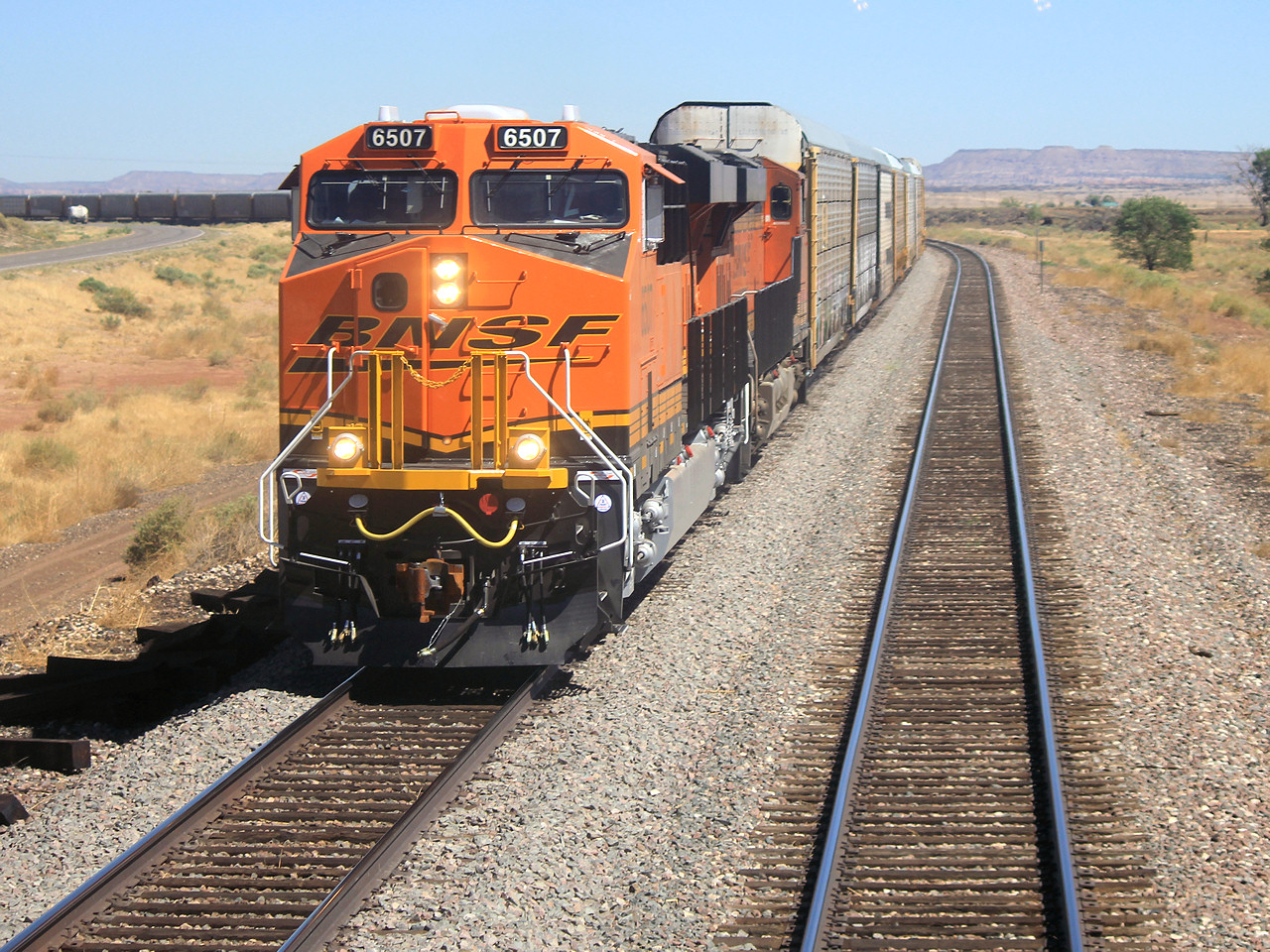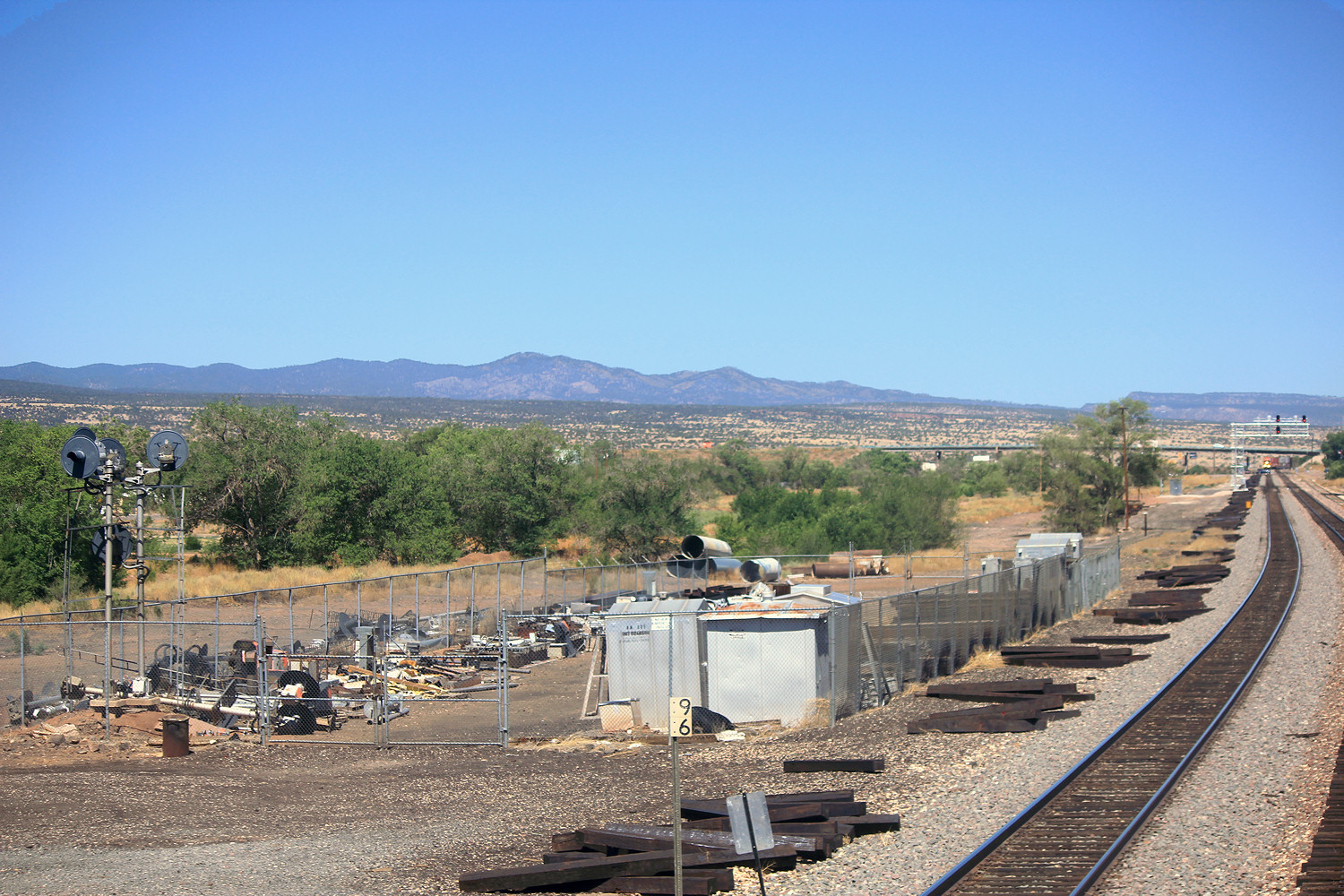You can find all the photos from this and the previous set here and if you'd like more information on the BNSF Gallup Subdivision here
Starting off west of Gallup the right of way splits for some reason as we climb up to the Continental Divide. Here is a doublestack train on track #1 as seen from track #2.
Tree and a dump track with scenery. Nearby BNSF crews were repairing fence lines to keep cows off the track.
A second stack train headed west on track #1.
Here we see the Continental Divide at Campbell Pass, 7270 feet about sea level. While higher than the 5200 foot crossing on the Great Northern Hi-Line and not in a tunnel like the DRG&W Mofat route, the ATSF crossing is rather tame with no epic scenery and not even a sign to mark the occasion. Even more bizarre is that this isn't the high point on the line with two additional higher 7000+ foot crossings on the Raton Pass route.
Just east of the summit the tracks rejoin and we find C44-10W #7351 heading westbound towards and Approach Limited signal to cross back over behind our train at Gonzales interlocking.
Fellow C44-10W #7323 was on the rear pushing at Thoreau.
The Thoreau wye was being used as a transloading facility for non-conventional oil.
The tracks split again before we pass by some local color.
Autoracks and stacks seem way over on track 1 from track 2.
This corridor supported all forms of transportation from the ATSF railroad, to Interstate 40 and NM State Highway 122 to a dude on horseback.
At this point we star to pass eastbound intermodal trains on track #2 the first of which is lead by C44-10W #7865.
Next up in the Conga line is #6507 leading a string of autoracks. #6507 is the lead unit of the large ~2012 order of GE ES44C4's and was purchased singly to test out the 6 axle, 4 motor concept.
Here's another new ES44C4 #6560 with doublestacks at Grants, NM.
Remains of the old searchlight signaling scheme are visible at the Grants MoW yard. These new (1980's/90's) searchlights are probably victims of the PTC panic pushed by the signaling industry to get railroads to replace all their hardware ahead of schedule.
East of Grants there was an MoW detail stretching out on track #2.
The line of MoW vehicles stretched on for quite some distance.
A few miles later another crew was taking advantage of the MoW posession to work on a back country grade crossing.
Still plenty of non-Iron horses hanging out near the tracks.
Pair of C44-9W's #'s 4672 and 4150 amoung others at the head of a mixed freight train at McCarthys. These two were part of a massive 1500 unit order from GE.
It's another conga line, westbound this time, with ES44C4 #6597 and a string of doublestacks. This is at least the third new 6500 series GE I had seen that day.
Truss bridge at MP 62.
After miles and miles of flat high speed terrain the route entered a twisty curvy bit with lots of speed restrictions as seen in advance of this hard rock cut.
Some of these speed restrictions were protected by inert ATS shoes that would require non-conditional ATS acknowledgement in the cab. Here is one at MP 60.4 for westbound trains. The IIATS system works by using a pair of metal plates to respond to a signal being generated by the train via inductive coupling. If power is applied a choke coil is cut into the circuit preventing the return signal and allowing the train to pass without an ATS activation. This fail safe system allows non-conditional shoes such as these to be mounted on the track without any signaling logic to drive them. These shoes happen to be situated in non-ATS territory, but function as all trains on the line must still be ATS equipped.
ES44AC #6542 with doublestacks waiting for us to cross ahead of it at Marmon. This made a total of 4 6500 series GE's!
Here is a 6 GE lashup on an westbound train on track 2 that was also waiting for us to cross over and clear up. So many engines I couldn't fit them in one pic.
Another two helpers were on the rear for a total of 8 engines. Included amoung these was ES44C4 #6906.
Former Route 66 overpass at Milepost 50. You know I never got why Rt 66 got so much credit seeing as it didn't even cross the entire country like Rt 30 or a host of other US highways.
C44-10W on a siding with autoracks at Highland Meadows.
The tracks split again at Milepost 46. Since ATSF resignaled this section back when they still cared it was given bi-directional ATS instead of the single directional setups that BNSF currently chooses to get away with.
Here is a brief video on the split track section showing off the 90mph running. The featureless terrain makes it look slower than it actually is.
Taking the turn off at DALIES interlocking onto the BNSF Glorieta Sub. The break in Millage is due to the current "main line" that continues on to Belen, NM being built after the original route which had its Zero milepost in Albuquerque after the count reset from Chicago. If Amtrak is forced to move the Southwest Chief off the now largely abandoned Raton Pass line trains would continue on to Belen and then eventually Kansas via Amarillo, TX.
That's it for part three. Next week we enjoy the bold rails of Albuquerque as he set out to enjoy the scenery and semaphores on our way to the Las Vegas that Amtrak still serves.































No comments:
Post a Comment